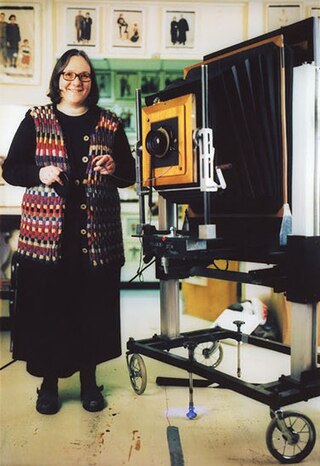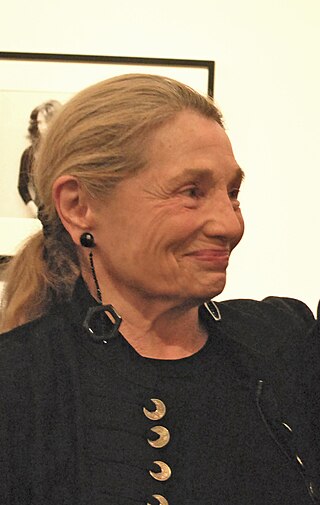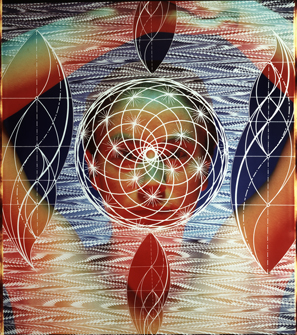
Errol Mark Morris is an American film director known for documentaries that interrogate the epistemology of their subjects, and the invention of the Interrotron. In 2003, his documentary film The Fog of War: Eleven Lessons from the Life of Robert S. McNamara won the Academy Award for Best Documentary Feature. His film The Thin Blue Line placed fifth on a Sight & Sound poll of the greatest documentaries ever made. Morris is known for making films about unusual subjects; Fast, Cheap & Out of Control interweaves the stories of an animal trainer, a topiary gardener, a robot scientist and a naked mole rat specialist.

An instant camera is a camera which uses self-developing film to create a chemically developed print shortly after taking the picture. Polaroid Corporation pioneered consumer-friendly instant cameras and film, and were followed by various other manufacturers.

Large format photography refers to any imaging format of 9 cm × 12 cm or larger. Large format is larger than "medium format", the 6 cm × 6 cm or 6 cm × 9 cm size of Hasselblad, Mamiya, Rollei, Kowa, and Pentax cameras, and much larger than the 24 mm × 36 mm frame of 35 mm format.

Susan Meiselas is an American documentary photographer. She has been associated with Magnum Photos since 1976 and been a full member since 1980. Currently she is the President of the Magnum Foundation. She is best known for her 1970s photographs of war-torn Nicaragua and American carnival strippers.

Roger Fenton was a British photographer, noted as one of the first war photographers.

Instant film is a type of photographic film that was introduced by Polaroid Corporation to produce a visible image within minutes or seconds of the photograph's exposure. The film contains the chemicals needed for developing and fixing the photograph, and the camera exposes and initiates the developing process after a photo has been taken.

Elsa B. Dorfman was an American portrait photographer. She worked in Cambridge, Massachusetts, and was known for her use of a large-format instant Polaroid camera.
The following outline is provided as an overview of and topical guide to photography:
Joyce Tenneson is an American fine art photographer known for her distinctive style of photography, which often involves nude or semi-nude women.

Analog photography, also known as film photography, is a term usually applied to photography that uses chemical processes to capture an image, typically on paper, film or a hard plate. These processes were the only methods available to photographers for more than a century prior to the invention of digital photography, which uses electronic sensors to record images to digital media. Analog electronic photography was sometimes used in the late 20th century but soon died out.
Marie Cosindas was an American photographer. She was best known for her evocative still lifes and color portraits. Her use of color photography in her work distinguished her from other photographers in the 1960s and 1970s. Most of her photographs were portraits and pictures of objects like dolls, flowers, and masks.
No Hair Day: Laughing Our Way Through Cancer is a 1999 documentary film about a photo-shoot of three women undergoing treatment for breast cancer, which was broadcast on PBS on October 10, 2001, as part of the Independent Lens series and on WGBX-TV.
B-Sides or B-Side may refer to:

The Polaroid 20×24 camera is a very large instant camera made by Polaroid, with film plates that measure a nominal 20 by 24 inches, giving the camera its name, although at least one camera takes pictures that are 23 by 36 inches.

Dody Weston Thompson was a 20th-century American photographer and chronicler of the history and craft of photography. She learned the art in 1947 and developed her own expression of “straight” or realistic photography, the style that emerged in Northern California in the 1930s. Dody worked closely with contemporary icons Edward Weston, Brett Weston and Ansel Adams during the late 1940s and through the 1950s, with additional collaboration with Brett Weston in the 1980s.

Wormwood is a 2017 American six-part docudrama miniseries directed by Errol Morris and released on Netflix on December 15, 2017. The series is based on the life of a scientist, Frank Olson, who worked for a secret government biological warfare program at Fort Detrick, Maryland. It focuses on the events leading up to and following his controversial death, which the US government originally claimed was a tragic accident, but later admitted was likely a suicide, caused by a mental breakdown brought on after being unknowingly dosed with LSD, while at a meeting with colleagues from the CIA who were involved in Project MKUltra. It also follows Frank Olson's son in the present day, and discusses his belief that his father may have been murdered due to being perceived as a potential security risk. Interspersed between interviews and archival footage, are live action reenactments of the final days of Frank Olson's life and the various theories involving his death.

Cynthia MacAdams is an American actress and photographer. She is recognized for her black and white portraiture, use of natural light and infrared photography, and images of sacred architecture.

American Dharma is a 2018 British-American documentary film directed by Errol Morris. The film follows the career of political strategist Steve Bannon. The film was released on November 1, 2019, by Utopia.

Ellen Carey is an American artist known for conceptual photography exploring non-traditional approaches involving process, exposure, and paper. Her work has ranged from painted and multiple-exposure, Polaroid 20 x 24, Neo-Geo self-portraits beginning in the late 1970s to cameraless, abstract photograms and minimal Polaroid images from the 1990s onward, which critics often compare to color-field painting. Carey's sixty one-person exhibitions have been presented at museums, such as the Amon Carter Museum of American Art, International Center of Photography (ICP) and Wadsworth Atheneum Museum of Art, alternative spaces such as Hallwalls and Real Art Ways, and many commercial galleries. Her work is in numerous museum collections, including those of the Metropolitan Museum of Art, Whitney Museum of American Art, Los Angeles County Museum of Art, Centre Pompidou, and Smithsonian American Art Museum. In 2019, she was named one of the Royal Photographic Society (London) "Hundred Heroines", recognizing leading women photographers worldwide. Los Angeles Times critic Leah Ollman describes her photography as "inventive, physically involving, process-oriented work" and her recent photograms as "performative sculptures enacted in the gestational space of the darkroom" whose pure hues, shadows and color shifts deliver "optical buzz and conceptual bang". New York Times critic William Zimmer wrote that her work "aspires to be nothing less than a reinvention, or at least a reconsideration, of the roots or the essence of photography." In addition to her art career, Carey has also been a longtime educator at the Hartford Art School and a writer and researcher on the history of photography.
The Polaroid Collection was a collection of fine-art photographs assembled by the Polaroid Corporation. The collection was initiated in the 1940s by Ansel Adams and Edwin Land. Following the company's 2008 bankruptcy, the collection was broken up for sale in 2010.













